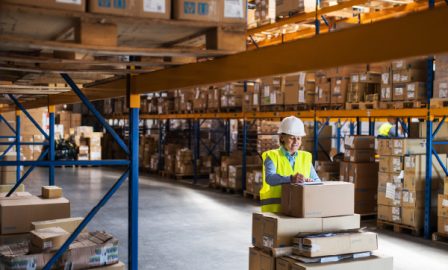Emerging Technology Trends in the Distribution Industry
The people responsible for running large distribution centers are always looking for ways to improve productivity and reduce operation costs. Innovative distribution industry leaders are looking at the latest technology to see if they can leverage some of the cutting-edge technology to do just that. Two such technologies that hold the most promise for DC managers are:
- Drones
- Artificial intelligence license plate scanning technology
Drones in the Distribution Industry
Drones have become very popular with hobbyists who fly them and capture unique images and videos. Innovative distribution center leaders have started exploring the use of drones to overcome some of the common challenges their teams encounter.
For example, at many large distribution centers there are many trailers in a yard at or near the DC. Managing that trailer inventory often requires an almost never-ending task of doing yard audits. Typically, this involves someone in a vehicle of some kind driving around and recording/verifying trailer numbers and the yard location that the trailer is parked in – a relatively tedious task as one can imagine.
Some innovative DC managers are experimenting with using a drone/camera to fly around the yard, while the operator stays in the DC office, performing the trailer audits remotely. Cameras on the drone can verify the trailer number/yard location accuracy as well as confirm that trailers are empty and available versus partially or fully loaded. They might mark damaged trailers with easily visible temporary red placards and look for those to count/confirm damaged trailers in the yard.
Drones are also being used to check the exterior structure of distribution centers. They can be used to look for and/or confirm a suspected problem on the walls or roof, without the need for people to be climbing up on ladders and rooftops with a risk of falling. Once a suspected problem has been identified or confirmed, only then would a person be deployed to further investigate the situation or perform the repairs.
A third use of drones that is being explored is counting inventory in tall racks without the need for a person to be raised to the racks in a reach truck or to drop down product to be counted. Camera-mounted drones are flown to the racks to see the materials and count them. Using this approach, the drone can quickly fly up, look into a rack, then proceed down the row of racks. After capturing video of all the contents of the high racks, the video can be reviewed and the counts entered. Needless to say, this is a much quicker process than hoisting a person up, doing the counts, lowering the person, and moving the hoist truck to the next count location and repeating the process or lowering the contents of the racks so they can be counted.
It can be expected that the future will include drones with bar code scanners and imbedded mobile terminals to perform transactions the same as a hand-held RF gun. This would allow inventory count transactions to be performed by the drone in the warehouse and also be useful in the trailer counting process discussed above.
Artificial Intelligence Automated License Plater Readers in the Distribution Center
Another emerging technology is Artificial Intelligence (AI) Automated License Plate Reader (ALPR) technology. ALPR systems consist of high-speed cameras mounted on police vehicles that are tied into a computer system networked to a license plate database. This technology is proven but still in the early adoption stage by police forces both in the United States and internationally. These high-speed camera systems can capture up to 60 license plates per second and the computer compares the captured license plates against a database of “wanted” license plates. The license plates in the database can consist of everything from outstanding parking tickets to vehicles reported as part of “Amber Alert” or other criminal activity. They scan all the vehicles around them, both parked and in traffic and alert the officer or officers in the vehicle when a wanted license plate has been seen.
Warehouse visionaries are looking into how this ALPR technology could be adapted to reading material pallet “license plates” to perform continuous cycle counts of products in the warehouse as fork trucks or a golf cart are driven around the warehouse. There are challenges and potential limitations, such as not being able to “see” behind the front pallet which may limit the technology to single deep locations. But the future might possibly see a “cycle count” vehicle that drives through the warehouse with ALPR cameras on a pole/tower aimed at the different levels of rack in a warehouse, performing cycle counts simply by driving down the aisle. The time savings compared to current approaches would be immense.
The takeaway from all of this is that innovative warehouse visionaries never stop looking at new technologies and asking themselves “How can I apply this to my warehouse?”
Subscribe to Clarkston's Insights
Contributions from Skip Berry


